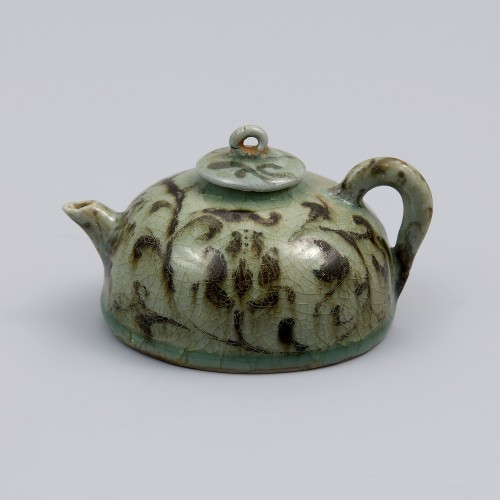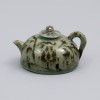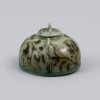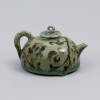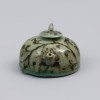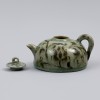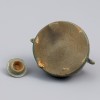본문
뚜껑이 있는 고려시대 반구형 소형 주자입니다. 연적의 용도로 추정됩니다. 철화청자는 해남 진산리 가마터 등지에서 처음 제작되기 시작하였으며, 강진에서도 주로 소형 기종을 중심으로 철화 기법이 활용되었습니다.
뚜껑 꼭지의 작은 구멍은 끈을 끼워 고정할 수 있도록 만들어졌습니다. 동체부터, 뚜껑, 주구, 손잡이까지 전반에 걸쳐 철화 안료로 화당초문이 시문되어있습니다. 철화 안료는 유약에 반응해 번지기 쉬우나, 이 매병은 소형임에도 문양이 선명하고 섬세하게 표현되었습니다.
바닥면을 제외한 표면 전체에 녹청색이 감도는 유약이 시유되었으며, 빙렬이 관찰됩니다. 백색 내화토를 받쳐 구운 흔적이 남아 있어 소성 방식을 보여줍니다.
━━━━━
这是高丽时期半球形小型执壶,有盖,推测为砚滴之用。铁画青瓷最早在海南珍山里窑址等地开始烧造,在康津地区也多以小型器类为主,采用铁画技法装饰。
盖钮上有小孔,用于穿绳固定。器身、盖子、流口和把手等部位皆以铁画颜料绘饰缠枝花纹。虽然铁画颜料在釉下容易晕散,此器虽小,却能清晰而细腻地呈现纹样。
除底部外,通体施釉,釉色泛青绿色,并可见开片。底部留有以白色耐火土支烧的痕迹,反映了其烧制方式。
━━━━━
This is a small hemispherical ewer with a lid from the Goryeo period, presumed to have been used as a water dropper. Iron-brown decorated celadon began to be produced at kiln sites such as Jinsan-ri in Haenam and later at Gangjin, mainly in small vessel forms.
The lid has a tiny perforation on the knob for fastening with a string. From the body to the lid, spout, and handle, the vessel is entirely decorated with scrolling floral patterns in iron-brown pigment. Although such pigment tends to blur under the glaze, here the motifs are rendered clearly and delicately, even on this small vessel.
A bluish-green glaze with visible crackle covers the entire surface except for the base. Traces of white refractory clay used for support remain, providing evidence of the firing method.
